

CarExpert.com.au
The CarExpert team's favourite cars of 2025
6 Hours Ago
Damien Reid gets an early drive of the new Audi RS3 hyper hatch and sedan in Greece ahead of its launch during the first half of 2022.
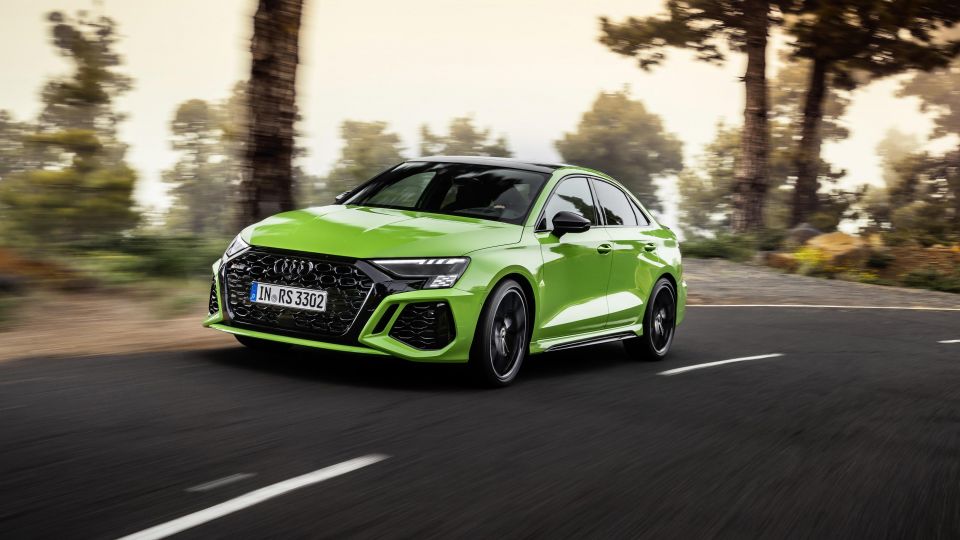
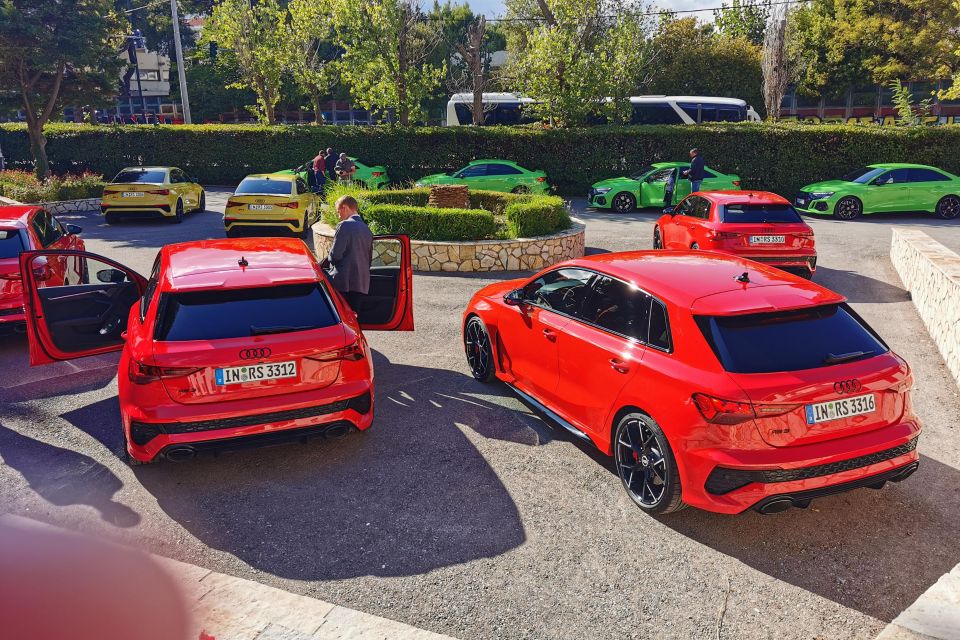

Contributor

Contributor


Contributor

Contributor
The third generation Audi RS3 is a rare breed by 2021’s standards, delivering its performance without electrification add-ons and the complications and weight that comes with it.
Given its more traditional architecture, Ingolstadt’s engineers have turned up the fun dial to deliver an emotive fire cracker that offers more of what Audi fans want but also eliminated some of its frustrations as well.
We got a first look at the new RS3 at the international media launch in Greece to see if it’s going to be worth the wait.

As with the current RS3, Audi is offering both sedan and five-door hatch options which isn’t surprising given it accounts for 30 per cent of A3 sales in Australia.
While prices for our market haven’t been confirmed, it’s a safe bet it will be more expensive than the outgoing generation when it lands in the second quarter of next year.
The previous Audi RS3 Sportback kicked off at $83,436 before on-road costs, while the RS3 Sedan was slightly dearer at $86,136 plus on-roads.
It’s unclear whether the RS3 Carbon Edition will carry over for the 2022 line-up. This model brought about some nicer trimmings and, of course, carbon-fibre for a $3400 premium.
The Audi RS3’s closest rival is the Mercedes-AMG A45 S 4Matic+, which currently lists for $99,712 before obligatory fees and taxes in Australia. Given Audi’s recent form, the RS3 should undercut the AMG.
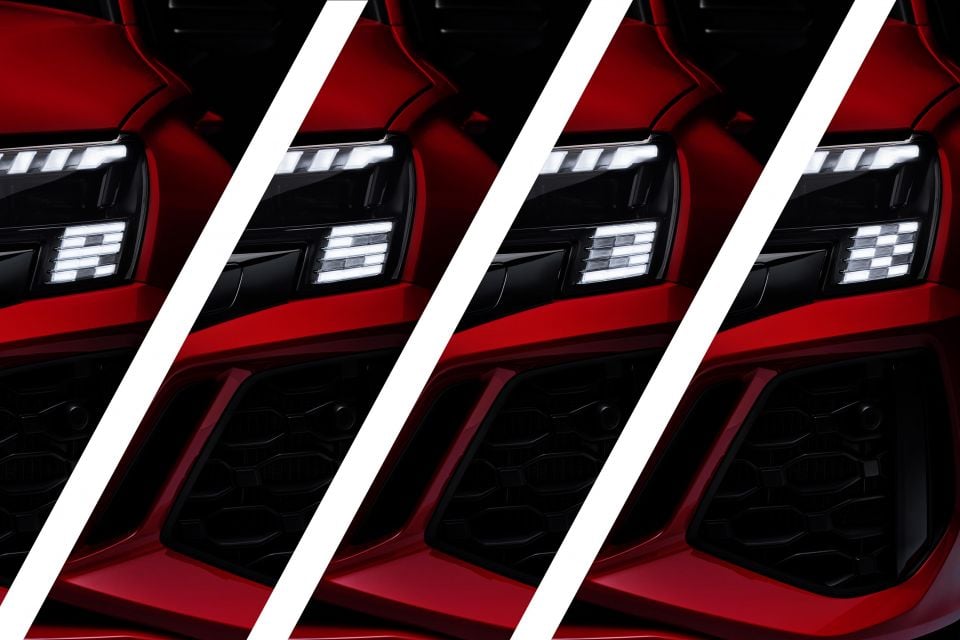
Buy your new car without the stress. It's fast, simple and completely free.

Great service from Travis and team, second time I have used this business would not hesitate to recommend them to anyone
Craig C.
Purchased a Ford Ranger in Sunshine Coast, QLD
CarExpert helped Craig save thousands on his Ford Ranger, now let us save you on your next new car.
Find a dealAside from launch colours that would make a Lamborghini blush, the RS3 is instantly identifiable by its wider front bumpers, housing air inlets for the brakes and intercooler, as well as its huge gloss-black honeycomb grille.
The flared front guards include signature oval-shaped exhaust outlets for the brakes and the headlights are split into three LED blocks – with ‘RS3’ lettering appearing on the driver’s side and a chequered flag on the other when the door opens, reverting to two chequered flags as daytime running lights when driving.
The exhaust system now features a fully-variable flap control system for a wider range of sound modes. Audi does warn, however, the RS3 doesn’t crackle and pop quite as much as it used to. A sports exhaust system is optional in Europe.
Six-piston front brakes are standard in Europe, with 380 x 38mm carbon-ceramic front brakes optional.
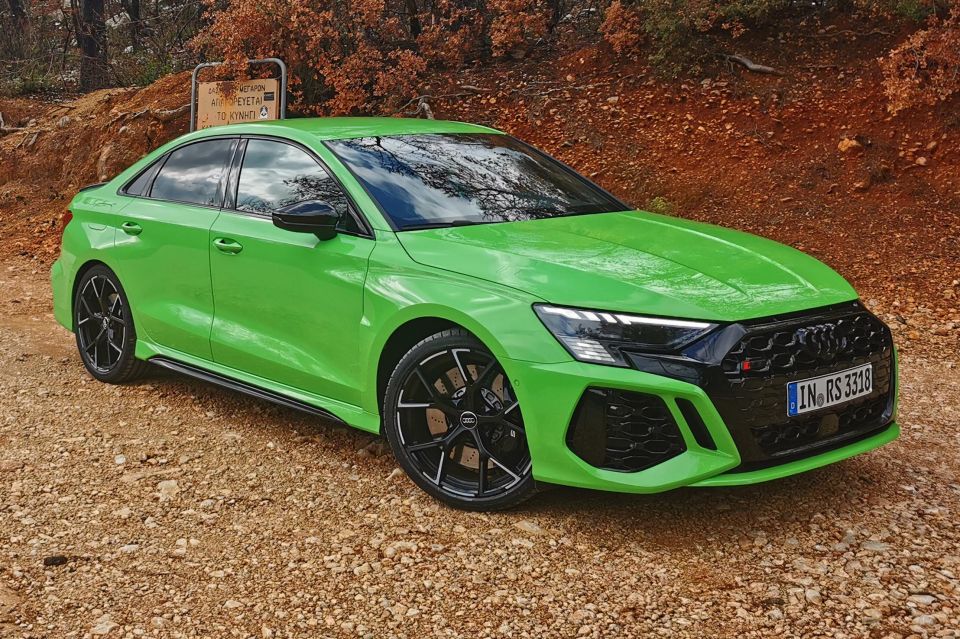
A high-performance brake system weighs 10kg less than the steel brakes and features 375 x 36mm ventilated and drilled discs at the front and 310 x 22 mm ones at the rear.
You can choose between black or red calipers for the steel brakes and grey, red or blue calipers for the ceramics.
The RS3 sits 10mm lower than an S3 and 25mm lower than an A3. It wears 19-inch wheels in Pirelli P Zero tyres, with semi-slick Trofeo R tyres optional.
Audi has ditched its Haldex all-wheel drive system for Audi’s new RS Torque Splitter. The new system allows for active and fully-variable torque vectoring between the rear wheels.

It features an electronically-controlled multiple-disc clutch on each drive shaft, with each clutch having its own control unit.
Up to 1750Nm of torque can be sent to the outer rear wheel. Audi says the torque splitter cuts understeer, allowing earlier and faster acceleration coming out of corners, and more precise and agile handling.
The new RS Torque Rear mode is what other brands would call Drift Mode. Up to 100 per cent of torque is sent to the outside rear wheel to get the RS3 sideways. The Mercedes-AMG A45 S has a similar system.
The new RS Performance Mode has been designed for the track, and is tuned for the optional Trofeo R semi-slick tyres.
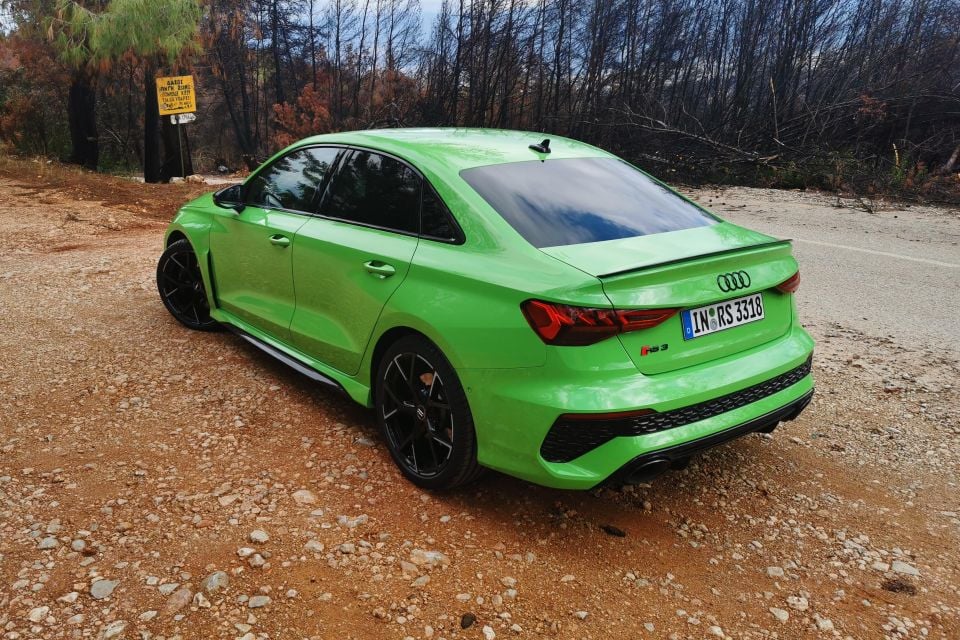
The optional adaptive suspension features a specific comfort setting for RS Performance Mode, designed for bumpy race tracks like the Nordschleife, while the standard RS sports suspension has newly-developed shock absorbers and a valve system specific to the RS3.
LED headlights are standard in Europe with Matrix LED headlights optional. Meanwhile the front track has been widened by 33mm, while the rear track is up by 10mm on the Sportback.
Pricing and specifications for the Australian market will be confirmed closer to launch.
MORE: 2022 Audi RS3 revealed
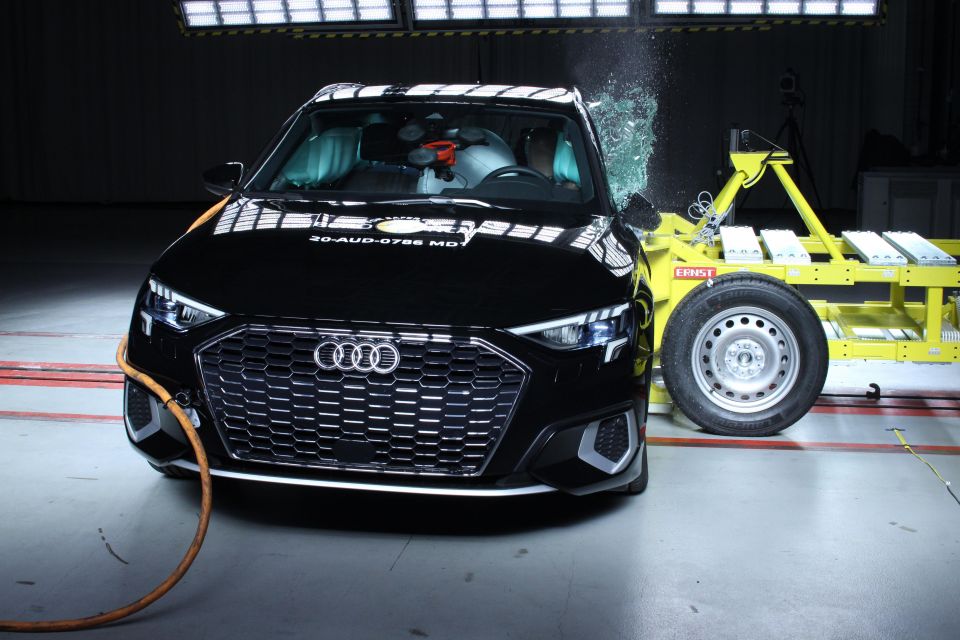
While the RS3 (and S3) are currently unrated by ANCAP or Euro NCAP, the new-generation Audi A3 line-up in Europe wears a five-star Euro NCAP safety rating based on tests conducted in 2020 – though quattro variants are also unrated.
The A3 managed 89 per cent for adult occupant protection, 81 per cent for child occupant protection, 68 per cent for vulnerable road users and 73 per cent for safety assist.
All A3 models coming to Australia will come standard with the following safety equipment:
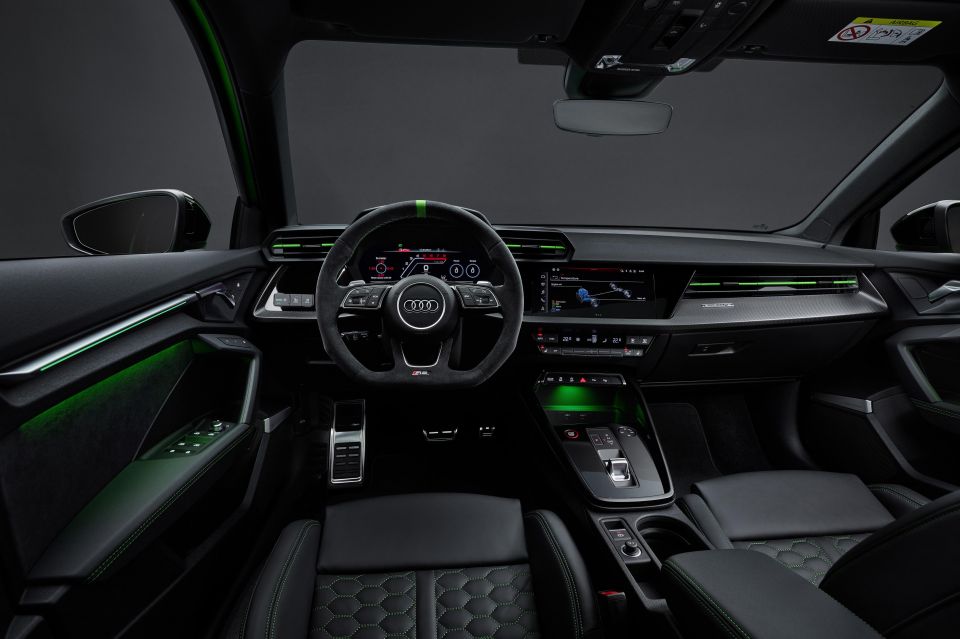
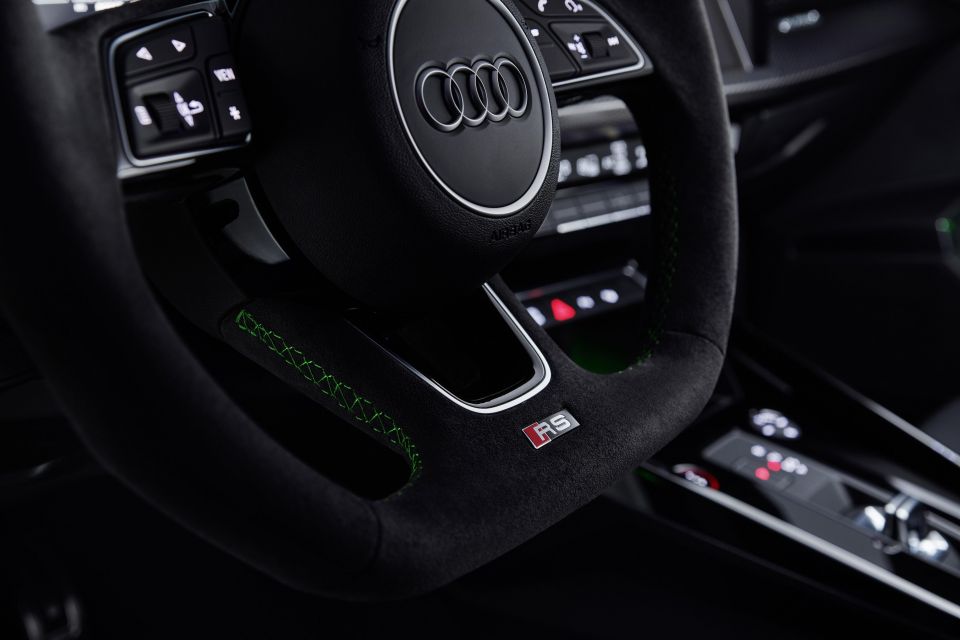
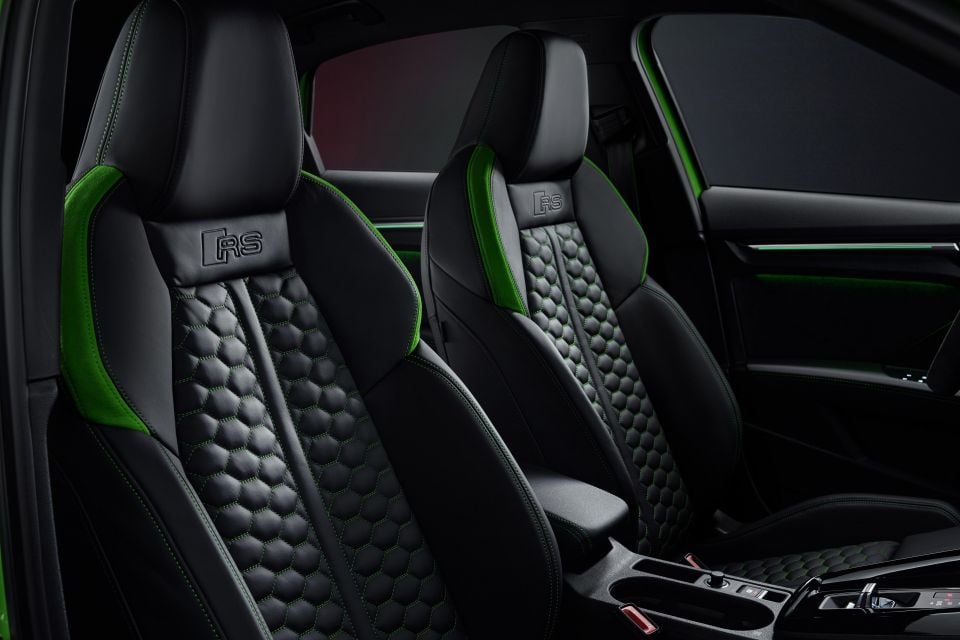
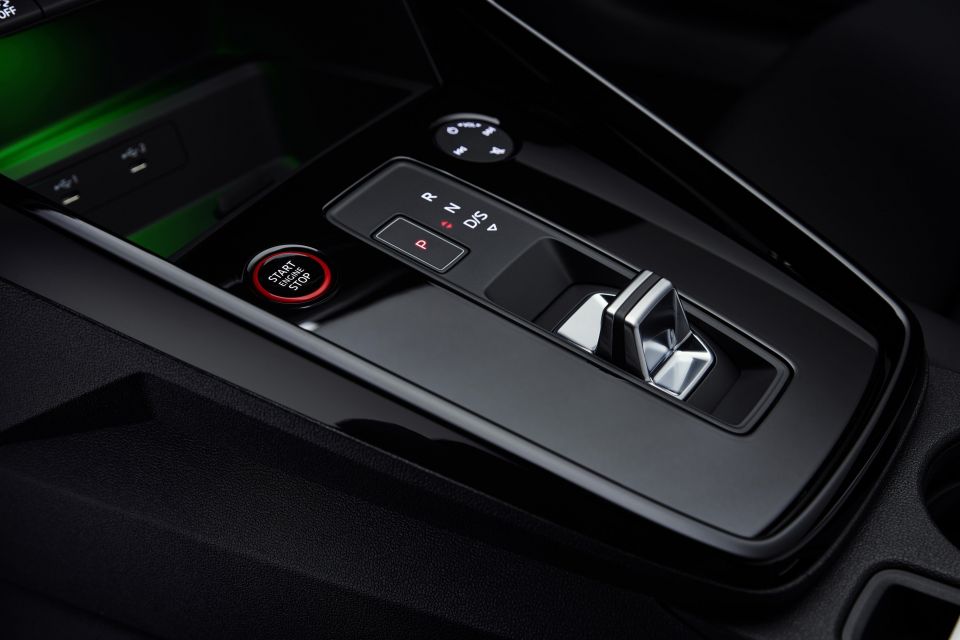
Step inside and the sporty aesthetic enhancements continue with the optional Nappa leather seats, which feature honeycomb stitching and a choice of black, red or bright green contrast stitching. Red and green RS Design packages are also available with colourful accents for the seatbelts, air vents and floor mats.
Carbon-fibre trim is used on the dashboard, while the standard leather-wrapped steering wheel features a flattened bottom and a button for the RS mode, and can also be had with a 12 o’clock stripe.
Behind it sits a pair of zinc paddle shifters and Audi’s 12.3-inch ‘virtual cockpit plus’ digital instrument cluster which features a distinctive new ‘RS Runway’ view mode. The RS3 will also offer the option of a head-up display.

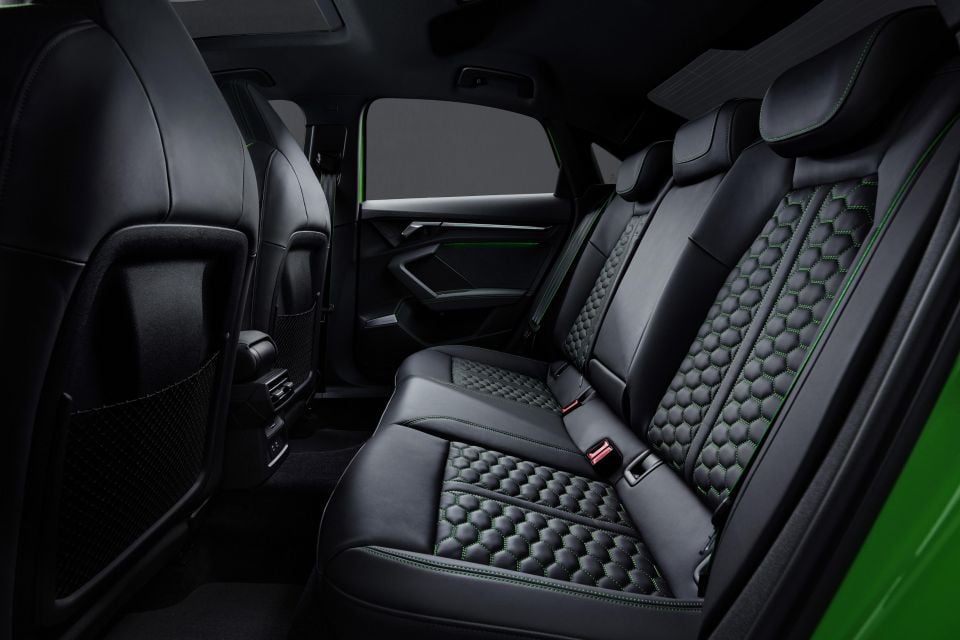
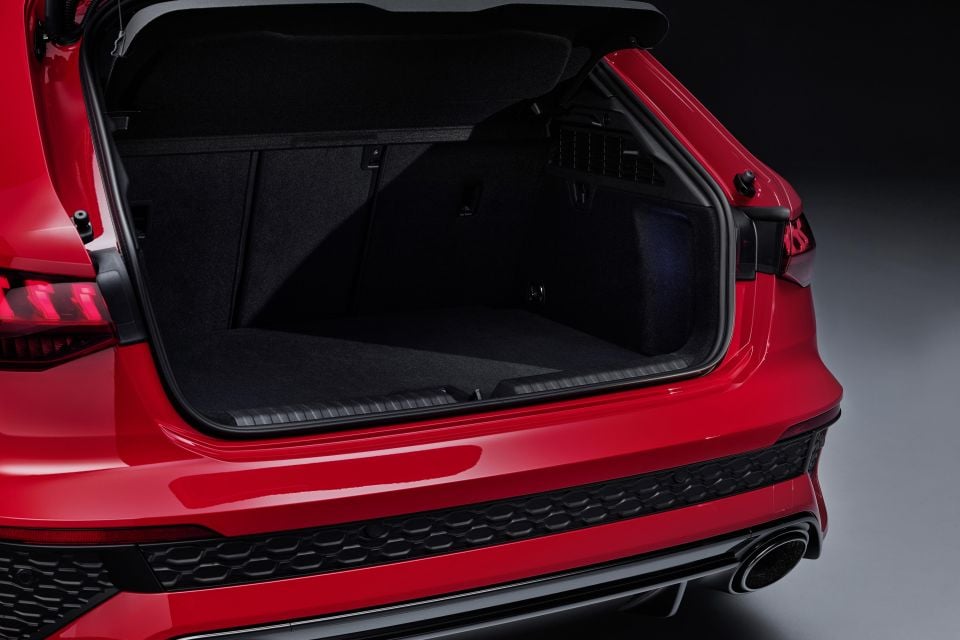
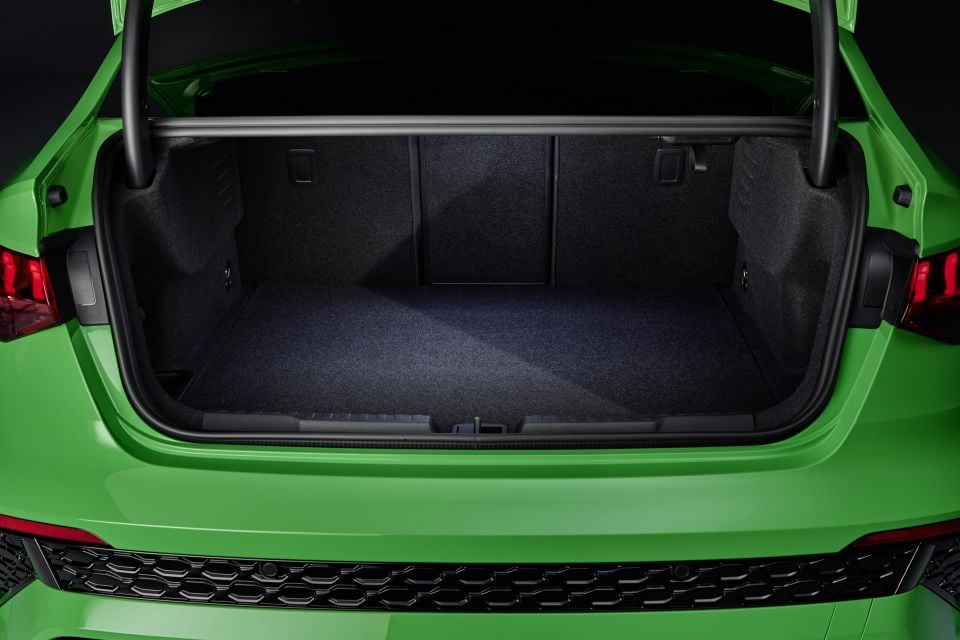
Despite its high-performance aspirations the RS3 remains an A3 at its core, meaning space for four adults should be ample.
Speaking of space, the RS3’s all-wheel drive system means quoted luggage space is a bit less than the standard A3 models according to European specifications.
The RS3 Sportback quotes 282L behind the second row of seats and 1104L with them folded, while the RS3 Sedan is more accommodating with 321L with the back seats in place, though there’s no figure with them folded.
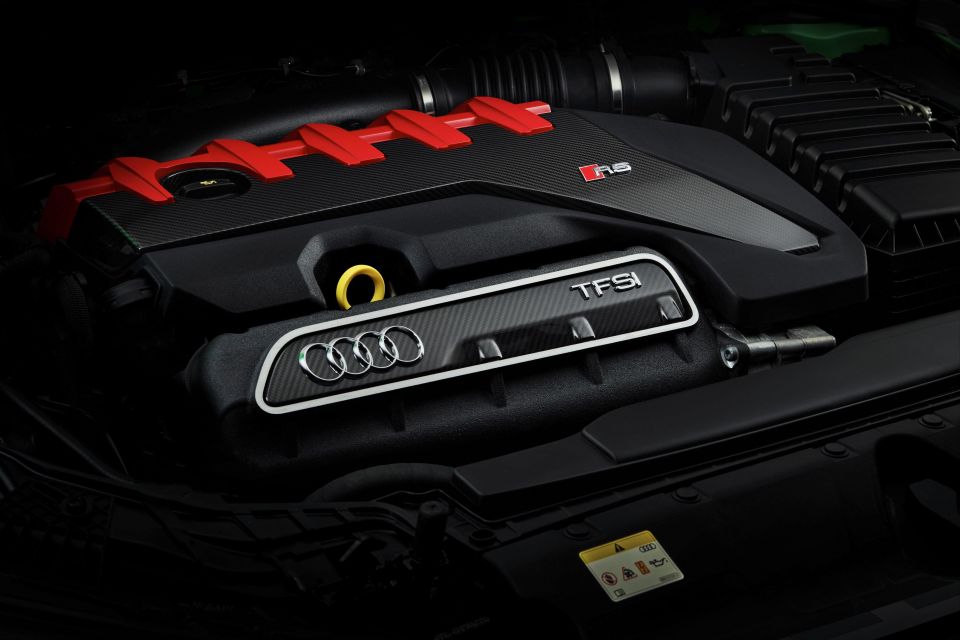
The RS3 still packs a turbocharged 2.5-litre five-cylinder engine, and while its power is unchanged at 294kW compared to the current model, it packs 20Nm more torque for a total of 500Nm.
Both the Sportback and sedan can do the 0-100km/h sprint in just 3.8 seconds, down from 4.1 seconds, while maximum power is now available at 5600rpm, down from 7000rpm.
A seven-speed S tronic dual-clutch automatic transmission continues to be the only transmission available.
Top speed is limited to 250km/h as standard, though a 280km/h top speed will be optional in Europe. The RS Dynamic package with carbon-ceramic brakes pushes that even higher to 290km/h.
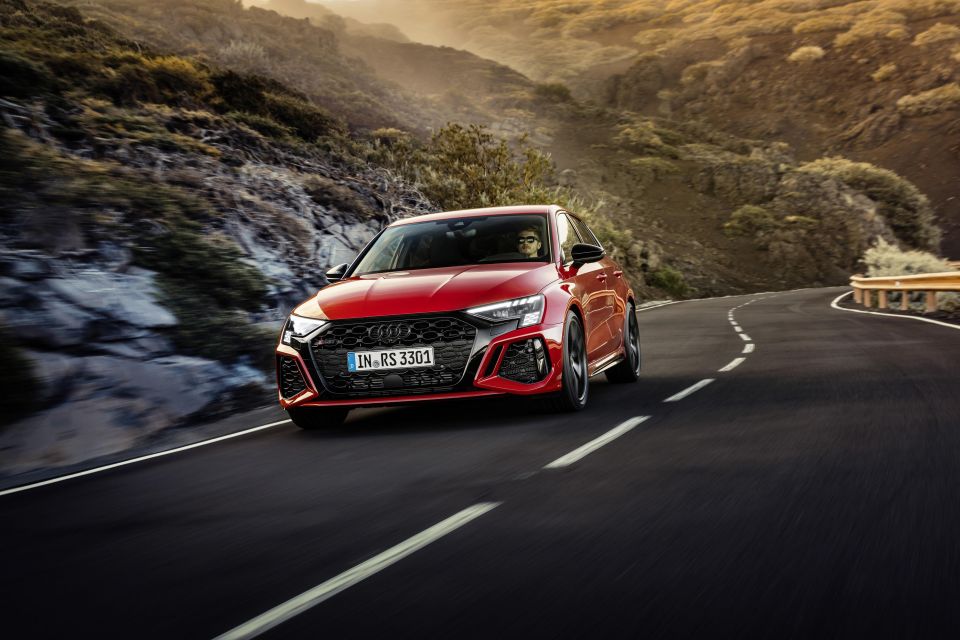
You can never get enough of that gorgeous five-cylinder growl, so it’s been amplified with a new exhaust that does justice to a tweaked engine and sharper transmission.
While there wasn’t too much to complain about with the previous generation, understeer has become an unwelcome Audi trait over the years. That’s been addressed with some clever trickery in the rear diff, to the point where the new RS3 offers a Drift Mode for track-day shenanigans.
Carried over from the previous model is the turbocharged 2.5-litre five-pot engine and its distinctive 1-2-4-5-3 firing order that evokes images of mud-splattered S1 Quattros from the halcyon days of Group B rallying.
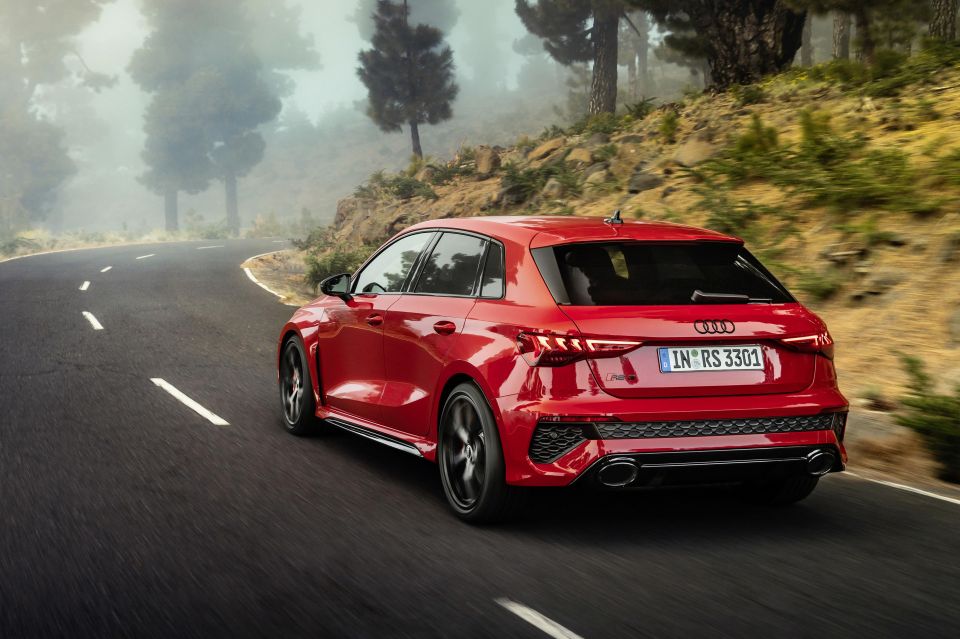
It’s accentuated by fully-variable exhaust flaps highlighting the music from a motor which gives an extra 20Nm of torque than before, offering 500Nm from 1800rpm with the same 294kW but arriving earlier at 5600rpm.
The seven-speed S-tronic dual-clutch transmission has shorter shifting times, and with launch control Audi claims the RS3 will get to 100km/h in 3.8 seconds and on to 250km/h or 290km/h in RS Dynamic mode – the latter requiring the RS dynamic package and carbon-ceramic brakes to be optioned.
Its party trick though is its clever ‘RS Torque Splitter’ vectoring rear axle that incorporates an electronically-controlled clutch on either side of the diff.
This means it sends more torque to the outer wheel for better grip and handling. Turn left and it sends torque to the right rear wheel. In Drift Mode it’s up to 100 per cent, handling up to 1750Nm per clutch if needed.
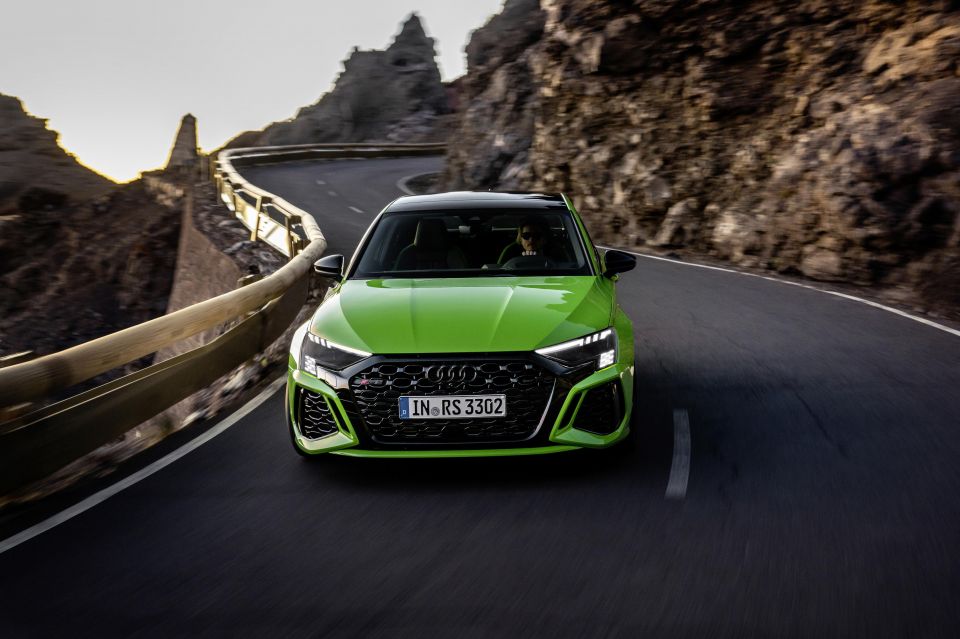
All up, there’s eight drive modes ranging from Efficiency which introduces coasting at idle through to Comfort, Auto, Dynamic, RS Individual, two modes of RS Performance and RS Torque Rear for drifting. RS Performance can be set for either smooth circuits or bumpy tracks like the Nordschleife.
Former DTM driver, Frank Stippler, used this setting to full advantage to set a Nürburgring lap record five seconds under the previous time at 7:40.748. It wore semi-slick Pirelli P Zero Trofeo R tyres, but that’s considered production-spec as Audi now offers these as an option for track days. Our test cars wore more modest 265/30 (front) and 245/35 (rear) Bridgestone Potenza S001 rubber.
The reality is, when kept in Dynamic mode for quick country road driving, the car feeds information back to the driver through the wheel and feels like it pivots on its sump plug with laser accuracy unlike any Audi in recent memory.
On winding roads, it lets you aim squarely at an apex, feel its nose tuck in tight, then even with a slight lift of the throttle induce a touch of oversteer. If anything it feels more mid-engined or rear-wheel driven, and thankfully has lost the traditional, all-wheel drive front-end wash out.
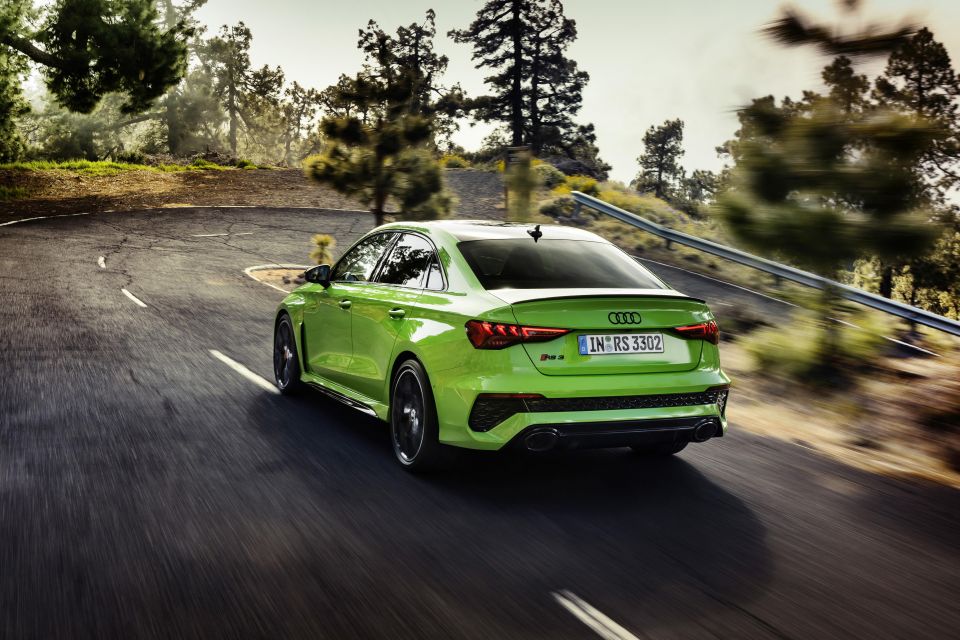
Where expert car reviews meet expert car buying – CarExpert gives you trusted advice, personalised service and real savings on your next new car.
Behind the 19-inch rims is a set of six-piston, 375mm x 36mm steel discs (310mm x 22mm on the rear) or optional 380mm x 38mm carbon-ceramic units that save 10kg of unsprung weight and are cooled with the help of a nifty air deflector mounted on the front wishbones.
The front wheels sit 33mm further apart, and the rear track is 10mm wider. To offset the wider track, just under one degree of negative camber has been added front and rear.
It’s a good thing there are two RS Performance settings as the car found every divot and rut on the exit of corners of a bumpy club race track, using them as an opportunity to do its best bucking bull impersonation scrambling for grip. Flicking it to the ‘bumpy track’ mode allowed it to absorb the uneven surfaces and get its power down earlier.
This mode also changes the 12.3-inch dash to a “runway” look where RPM numbers are displayed with the redline digits being the largest and closest to you as the smaller figures fade into the distance – think Star Wars opening titles. It also includes a G-force meter and lap timer with splits for 100km/h, 200km/h, 200m and 400m.

The new RS3 should be covered by Audi Australia’s three-year, unlimited-kilometre warranty like the wider range.
Service pricing will be confirmed at launch, but the outgoing model was available with a five-year service package priced at $3580.
Audi Australia plans to launch the new-generation RS3 during the first half of 2022. Stay tuned to CarExpert for all the latest updates over the coming months.
Click the images for the full gallery
MORE: Everything Audi RS3


CarExpert.com.au
6 Hours Ago


Damion Smy
20 Hours Ago


Damion Smy
23 Hours Ago


Damion Smy
1 Day Ago


Damion Smy
1 Day Ago


Damion Smy
1 Day Ago